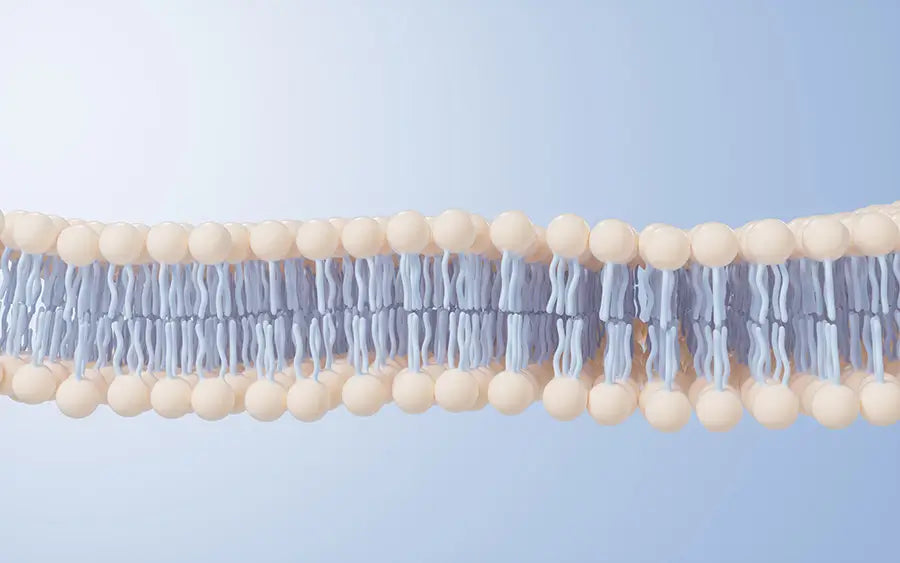
What are phosphatidylcholine liposomes? Learn how these artificial cells navigate through your body to deliver nutrients to the mitochondria and help strengthen the cell membrane.
by Robert D. Milne, M.D.
Since 2004 when LivOn Labs introduced the first dietary supplement made with liposome encapsulation technology, liposomes have been changing the way we supplement. For good reason. When made right, liposomal supplements enable elite nutrient absorption. When made with phosphatidylcholine (PC), liposomal supplements enable previously unfathomable benefits at the cellular level.
The purpose of this article is to explain why, when made with PC, liposomes are such effective nutrient delivery vehicles and why this matters to everyone seeking health and longevity.
What Are Liposomes?
Liposomes are sub-microscopic bubbles that surround various substances (like vitamins, minerals, and targeted therapies) to deliver pure, non-degraded substances to the specially targeted tissues and organs.
Liposome Structure
Liposomes are made from phospholipids, the basic building block of every cell membrane in the human body.
Phospholipid Structure
Each phospholipid molecule has three major parts, one head and two tails. The head is made from three molecular components: choline, phosphate, and glycerol. The important thing to remember here is that the head is hydrophilic; it is attracted to water. Each tail is a long, essential fatty acid chain. These fatty acids are hydrophobic; they are repelled by water.
When phospholipids are put in an aqueous (water-based) solution, the hydrophilic heads of the phospholipids form a line side by side with their tails behind. Then, because the tails are hydrophobic, another phospholipid layer lines itself up tail-to-tail in response to the same aqueous environment. This natural alignment creates two rows of tightly fitted phospholipid molecules, called a phospholipid bilayer.
It is these phospholipid bilayers that form the membranes around and within every cell in our bodies.
In the body, phospholipid bilayers form the outer wall for each cell by arranging themselves in a spherical shape with the heads of the phospholipids making up the external and internal surfaces of the cell. This sub-microscopic membrane holds the contents of the cell in and protects the cell from harmful substances on the outside.
Why Phospholipids Make Liposomes?
When making a liposomal supplement, phospholipids placed in a water-based solution arrange themselves in an identical pattern to surround a nutrient. The bilayers protect the valuable contents until delivery into the cell.
Because of their sub-microscopic size and a chemical structure that is recognizable as a friendly substance to the body, phospholipid liposomes can navigate through the digestive, lymphatic, and circulatory systems with ease. This is in contrast to some supplement tablets, pills, and capsules that can be eliminated in the stool.
The liposome’s identical composition to the cell membrane lets it slip into the cell and deliver its contents intact.
Phosphatidylcholine: Supporting Every Cell
Phosphatidylcholine is the essential phospholipid prevalent in cell membranes, but cannot be synthesized in the body. At birth, up to 90% of our cell membranes are made of it. By adulthood, that drops to just 10%. As an essential phospholipid, your body can’t produce it on its own—yet your cell membranes rely on it to repair damage from daily free radical exposure. It occurs naturally in soy lecithin, some animal proteins, and egg yolks.
Phosphatidylcholine makes ideal liposomes
Not all phospholipids can form strong, stable bilayers for liposomes. PC is reliable and resilient. Using PC also best mimics human cells, which means better transport through the body and assimilation into the cell membranes.
PC has been the subject of 500+ human studies, demonstrating not only its safety as a dietary supplement, but its benefits.
Nutritional benefits of phosphatidylcholine
A major reason PC is used in liposomes is its nutritional value at the cellular level. Decades of research demonstrate benefits of PC in the following domains:
- Exercise tolerance*
- Circulation*
- Liver health*
- Blood cell health*
- Cell membrane fortification*
- Neurotransmitter production*
- Antioxidant in fats*
Phosphatidylcholine helps strengthen cells
When PC is ingested, it quickly replaces the damaged phospholipids in cell membranes. Cells throughout the body become more able to resist the damaging effects of free radical attack.
The first line of defense for any cell in the body is the cell membrane. Once the cell membrane has been compromised, the mitochondria (the cell’s power plant), RNA, and DNA inside the cell are open to attack.
Studies show two major functions of PC in regard to individual cells — cell protection and cell repair. A constant supply of PC allows cells to replace damaged phospholipids within cell walls and also demonstrates an antioxidant ability.
Benefits of Liposomes Made with Phosphatidylcholine
Liposomal supplements made with phosphatidylcholine support absorption of encapsulated nutrients while reinforcing vulnerable cells.
- Protection of sensitive nutrients that often do not survive the digestive system in traditional supplements (pills, tablets, etc.)
- Elite absorption of encapsulated nutrients for potent health benefits
- Fewer GI side effects compared to non-liposomal forms, due to less excretion
- Health benefits from the phosphatidylcholine
When you’re looking for a liposomal supplement, make sure phosphatidylcholine is listed on the label. If it’s not, you’re missing out on the full health-changing potential of liposomes.
Explore the LivOn Labs line of PC-based liposomal supplements, the first dietary supplements made with liposome encapsulation technology.
Phosphatidylcholine liposomes FAQs
What is the role of Phosphatidylcholine in liposomes?
Phosphatidylcholine forms a bilayer around nutrients to encapsulate them, protect them through the digestive system, and deliver them to the cells. Because phosphatidylcholine is the same material that makes up the cell membranes, the phosphatidylcholine liposomes can merge into the cell and deliver the nutrients for absorption. Phosphatidylcholine assimilates into the membrane to replace degraded phospholipids and help fortify the cell.
What are the benefits of taking phosphatidylcholine?
Phosphatidylcholine helps strengthen cell membranes to protect every cell, and supports exercise tolerance, circulation, liver health, blood cell health, neurotransmitter production*. It also acts as an antioxidant in fats.
What is the best source of phosphatidylcholine?
Phosphatidylcholine is found in egg yolks and some animal proteins. It’s used to make liposomes in liposomal dietary supplements.

